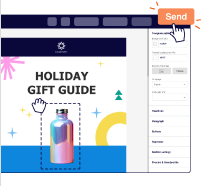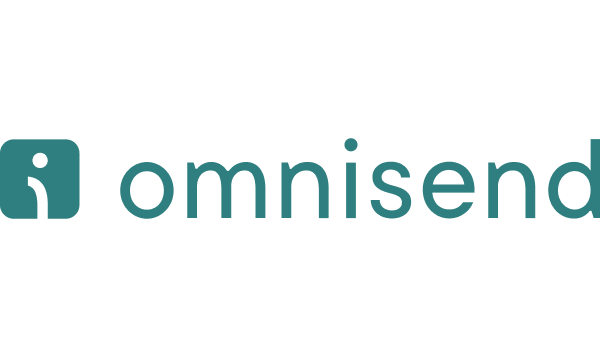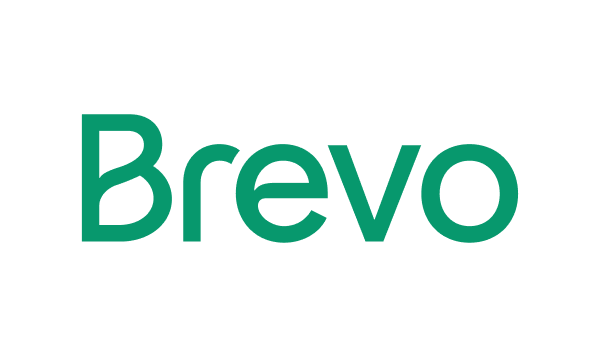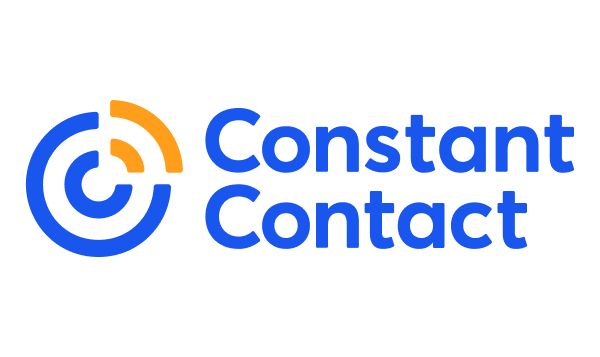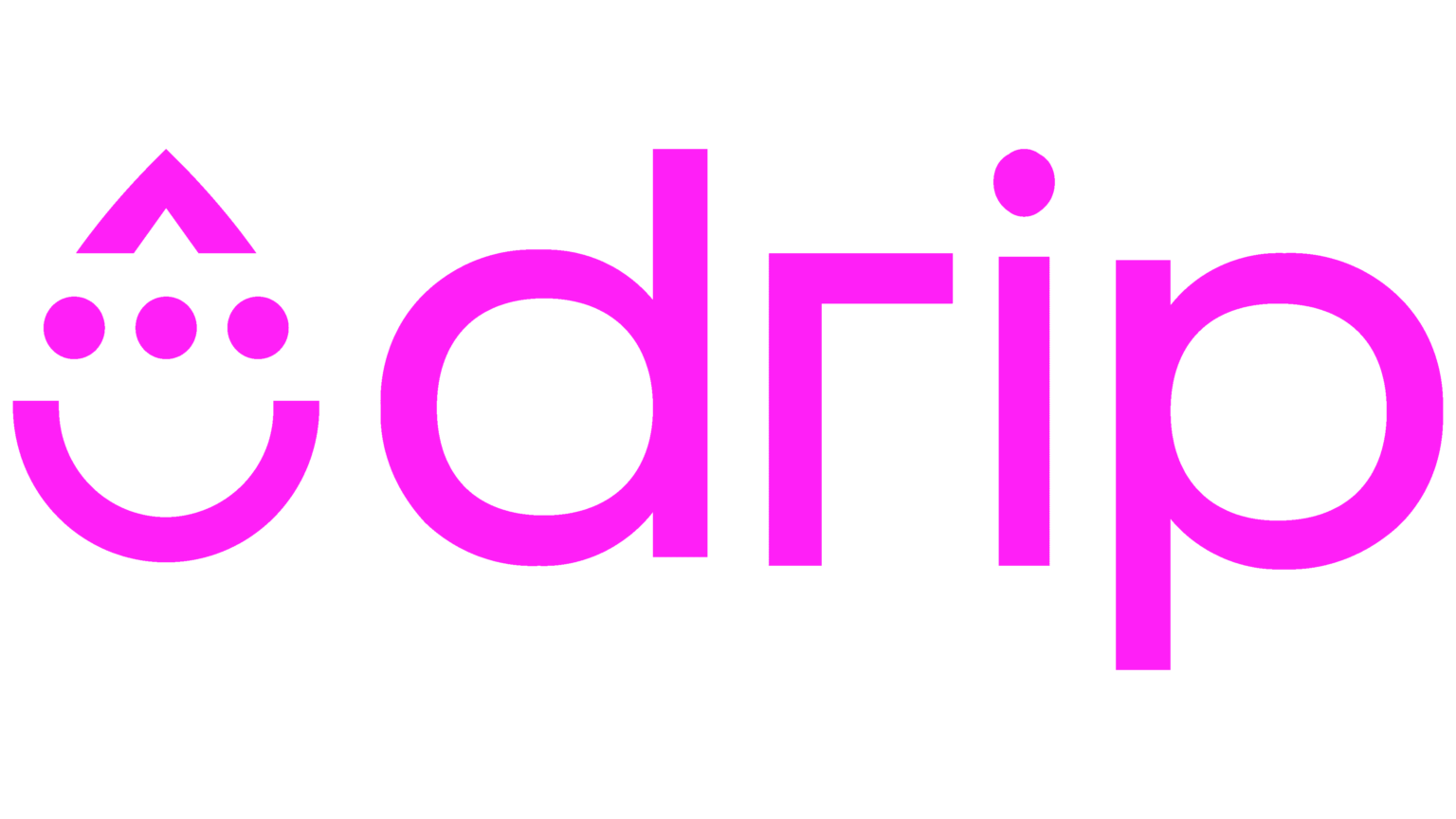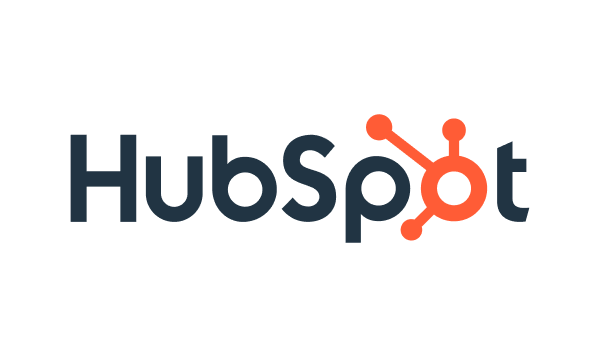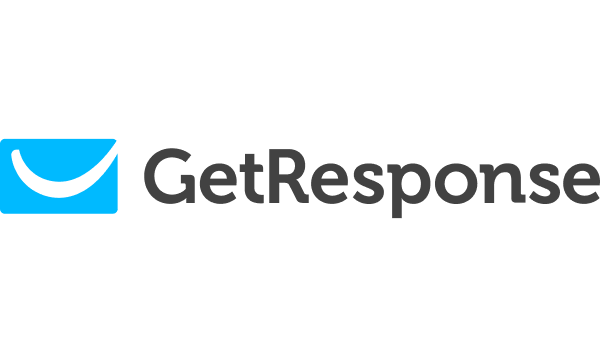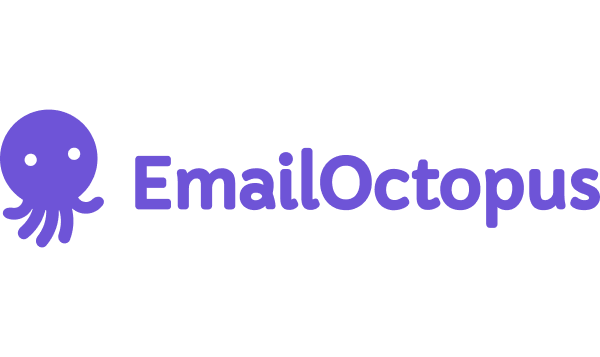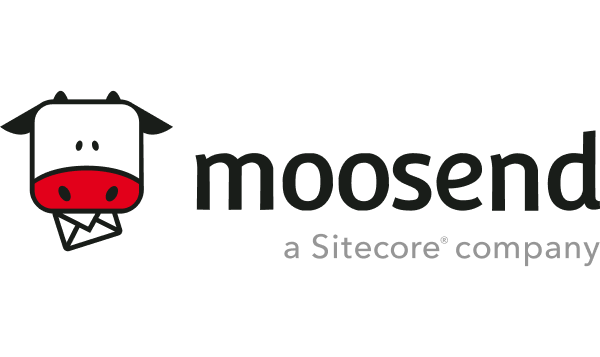Ever paid for an email tool, only to realize it’s too difficult to use? Or has a slow dashboard, bad deliverability, hidden costs, or any other inconvenience…
I’ve been in the industry for over a decade and understand which email marketing providers actually work and which are all hype but no actual substance.
If you’re looking for an email platform that delivers results without frustration—you’re in the right place.
I will break down the best tools for 2025, comparing key features, pricing, and what truly makes them stand out. No fluff. No misleading claims. Just honest insights to help you make the right choice.
Disclaimer: This article evaluates various email marketing services, including Sender, which our company owns. We present assessments based on research, industry standards, and user feedback. We selected these platforms after comparing their features, pricing, and performance. We don’t earn any commissions from links in this article.
Best Email Marketing Platforms at Glance
- Sender – Smart Alternative to Overpriced Email Platforms
- Omnisend – Top Choice for Ecommerce Marketing Automation
- Brevo – Budget-Friendly Option with Limited Advanced Features
- Klaviyo – Premium Ecommerce Platform with Steep Pricing
- Mailchimp – Popular Legacy Platform with Declining Value
- Constant Contact – Traditional Email Service with Outdated Interface
- Drip – Ecommerce Specialist with Email-Only Limitations
- HubSpot – Enterprise All-in-One Solution with High Cost
- GetResponse – Multi-Feature Platform with Jack-of-All-Trades Approach
- EmailOctopus – Email Marketing Service for Basic Needs Only
- Moosend — Affordable Automation Tool with Limited Templates
- MailerLite — Beginner-Friendly Platform with Basic Feature Set
- SendX – Simple Email Tool with Limited Scalability
- Kit – Creator-Focused Platform with Limited Business Applications
Before moving to detailed reviews, let’s compare the costs of using different email marketing platforms.
| Platform | User Rating(Trustpilot) | Price | Free plan | Best For |
| Sender | 4.8 /5.0 | Paid plans start at $7/month | Free plan available for up to 2,500 subscribers and 15,000 emails/month | Ecommerce, SMBs, Startups |
| Omnisend | 4.3 /5.0 | Paid plans start at $11/month | Free plan available for up to 250 contacts and 500 emails/month | Ecommerce brands |
| Brevo | 4.4 /5.0 | Paid plans start at $8/month | Free plan available for up to 100,000 contacts and 300 emails/day | Ecommerce, Startups |
| Klaviyo | 2.1/ 5.0 | Paid plans start at $20/month | Free plan available for up to 250 contacts and 500 emails/month | Advanced ecommerce teams, Agencies |
| Mailchimp | 2.8 /5.0 | Paid plans start at $12/month | Free plan available for up to 500 contacts and 1,000 emails/month | Enterprises, Marketing teams |
| Constant Contact | 4.2 /5.0 | Paid plans start at $12/month | 30-day free trial available for up 100 email sends | SMBs, Nonprofits, Event-led brands |
| Drip | N/A | Paid plans start at $39/month | 14-day free trial available for 100 emails per account and 2 email campaign sends/day | DTC Ecommerce Brands, Agencies |
| HubSpot | 2.0 /5.0 | Paid plans start at $10/month | Free plan available for up to 1,000 contacts and 500 emails/day | Enterprises, Agencies, Funded startups |
| GetResponse | 3.9 /5.0 | Paid plans start at $15/month | Free Forever plan available up to 500 contacts & 2,500 emails/month | SMBs, Ecommerce, Marketing teams |
| EmailOctopus | 4.6 /5.0 | Paid plans start at $12/month | Free plan available for up to 2,500 contacts & 10,000 emails/month | Small businesses, Creators, Startups |
| Moosend | 3.5 /5.0 | Paid plans start at $15/month | 30-day free trial available for up to 1,000 contacts with unlimited emails | Agencies, Ecommerce, SMBs |
| MailerLite | 4.4/5.0 | Paid plans start at $9/month | Free plan available for up to 1,000 contacts & 12,000 emails/month | Small businesses, Creators, Educational institutions |
| SendX | 2.2 /5.0 | Paid plans start at $8/month | 14-day free trial available for up to 500 contacts and 2,000 emails/month | Startups, SMBs, Creators |
| Kit | 1.9 /5.0 | Paid plans start at $25/month | Free plan available for up to 10,000 subscribers and unlimited emails | Shopify creators, Solo founders |
14 Best Email Marketing Services
From robust automation to impressive deliverability, I’ve considered everything that matters when it comes to the best email marketing tools. Dive into this comparison roundup to find the 14 best email marketing platforms.
Sender — Smart Alternative to Overpriced Email Platforms
If you need a combination of powerful and free for your email marketing campaigns, you shouldn’t look further than Sender. Whether you’re a complete beginner or a seasoned pro, this robust bulk email software makes email marketing effortless.
Even on its Free forever plan, Sender offers a premium email marketing package with features like advanced automation and segmentation that give competitors a run for their money.
Sender Pricing: Starts at $7/month for up to 2,500 subscribers and 12,000 emails/month | Free plan available.
Another great thing about Sender is that it strikes a rare balance between ease of use and advanced capabilities. You can create multi-step onboarding email sequences using the visual automation builder without touching a line of code. Also, the drag-and-drop editor is fast, responsive, and offers a rich gallery of email templates that look great across different devices.
Sender also comes with pre-built automation workflows for abandoned carts, product recommendations, win-back emails, and more. You can customize these workflows visually using its automation builder, making it easy to set up logic-based campaigns without hiring a developer.
The best part? All of this is available for a try-out on Sender’s free plan, which doesn’t pressure you into upgrading with time limits or essentials being tucked under pricier plans.
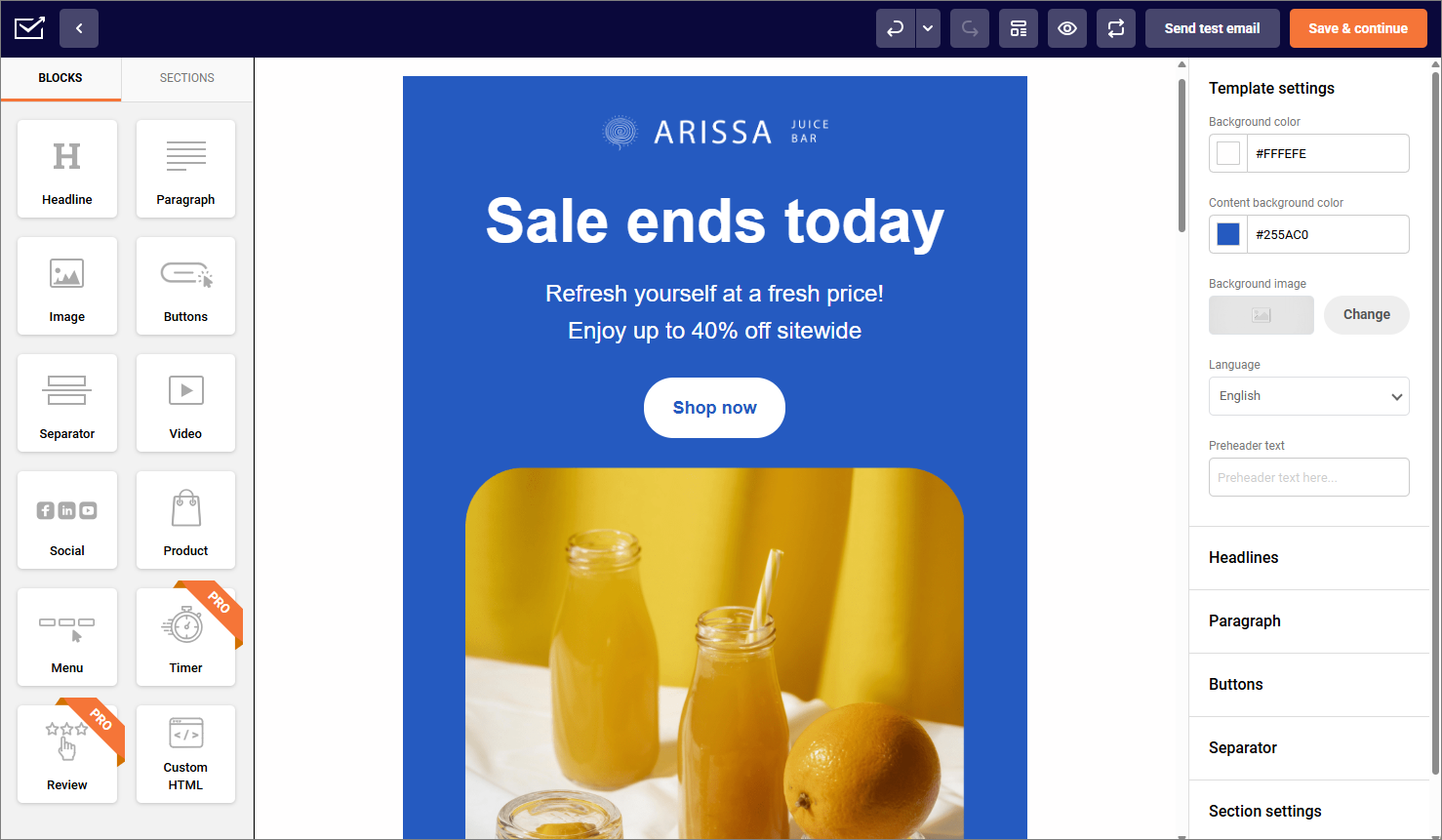
Key Features
- Advanced automation features. Sender offers powerful yet easy-to-use email automation workflows—ideal for targeted campaigns and lead generation;
- Deep segmentation. Trigger personalized email and SMS campaigns using contact data and behavior—no marketing team required;
- Real-time email reports. Monitor performance with clear, actionable metrics like opens, clicks, and conversions;
- Landing page builder. Create high-converting pages quickly with drag-and-drop tools, customizable templates, and built-in forms to capture leads;
- A/B testing. Test up to 8 combinations by mixing subject lines, sender names, etc. at once, letting you deliver the top-performing version for maximum impact.
- Generous free plan. Take out Sender’s advanced features for a spin before making a decision—no strings attached.
Use Cases
- Ecommerce. Ideal for online stores aiming to increase revenue through abandoned cart reminders, tailored product emails, and seamless platform integrations;
- Startups & SMBs. Designed for busy entrepreneurs looking for effective email marketing for small business—simple yet powerful tools to grow their audience;
- Bloggers & content creators. Sender is designed with content creators in mind, making it easy to reach subscribers with personalized newsletters and bulk email sender tools;
- Retail businesses. Use Sender for retail email marketing needs, such as seasonal promotions, local event invitations, and product announcements.
Pros & Cons
- Advanced automation workflows
- Generous free plan
- Landing page builder
- State-of-the-art segmentation functionality
- User-friendly interface
- In-depth analytics
- Free plan includes Sender branding
- Lacks built-in CRM features
Pricing Details
- Free tiers: $0 (2,500 contacts—15,000 emails/month);
- Standard: $7/month (1,000 contacts—12,000 emails/month);
- Professional: $14/month (1,000 contacts—24,000 emails/month);
- Enterprise: Custom price.
See why businesses choose Sender:
Omnisend – Top Choice for Ecommerce Marketing Automation
Omnisend is an all-in-one email marketing veteran tailored for ecommerce needs. Not only does it have nice trigger-based automations, but it also excels in behavioral workflows and omnichannel campaigns.
Omnisend pricing: Starts at $11/month for up to 500 contacts and up to 6,000 emails/month | Free plan available.
I tested Omnisend by building a multi-step cart abandonment + product recommendation flow using their visual branching builder, and had it live in under an hour. Omnisend also lets you layer email, SMS, and web push into one seamless automation without needing multiple tools or any coding skills.
The platform also supports dynamic content blocks, built-in product pickers (something Shopify store owners can only dream of), and offers ready-to-use templates that match ecommerce email marketing goals—not just pretty layouts.
However, its limited integrations and ecommerce focus, no matter how great, might not appeal to businesses outside the retail space or those needing a more well-rounded email marketing compatibility.
When it comes to its Free Forever plan, it supports up to 250 contacts and includes features like basic automation and A/B testing. That’s quite limited when compared to Sender, but that’s still a lot more than what most platforms offer at the basic level.
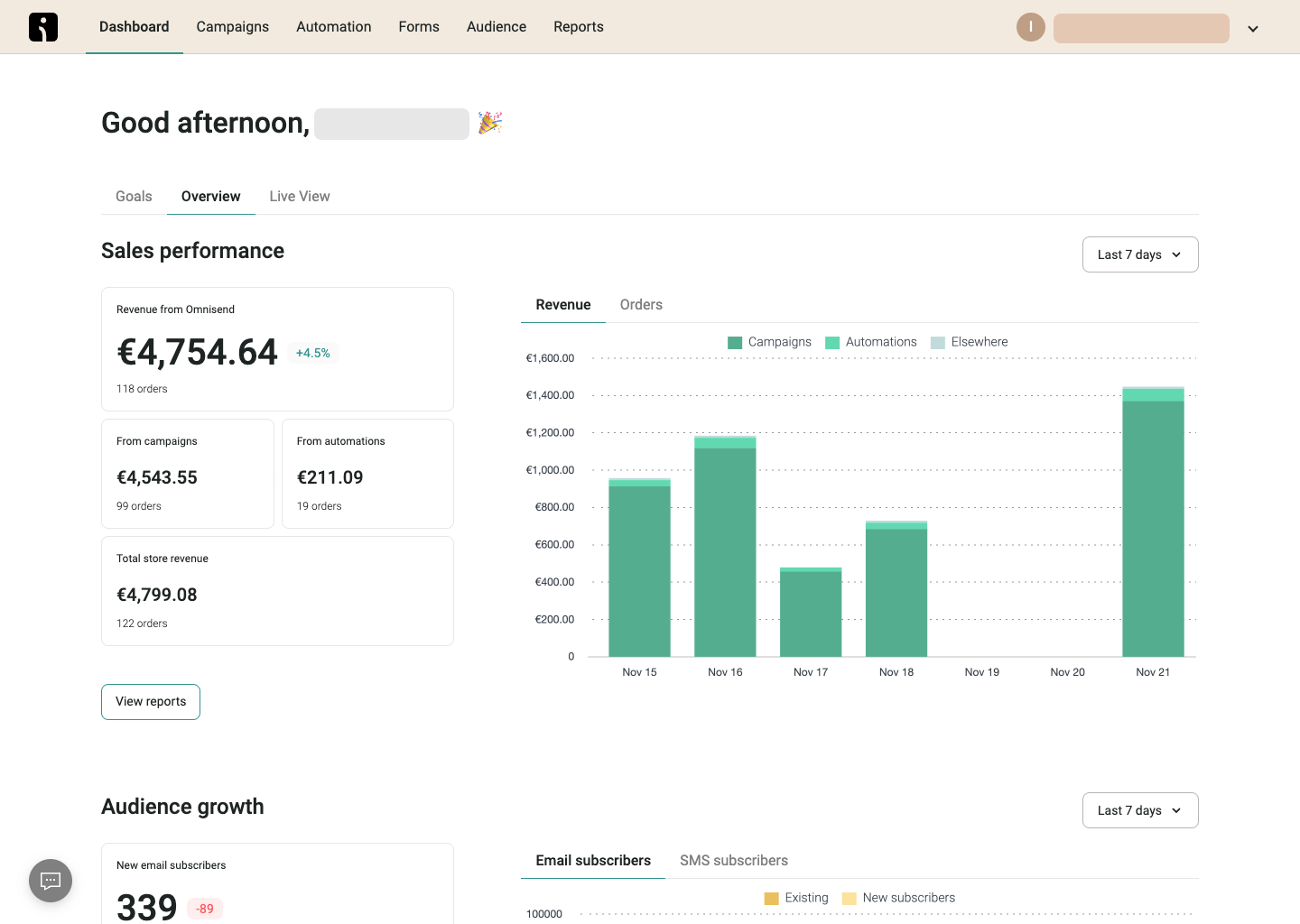
Key Features
- Omnichannel campaigns. Combine email, SMS, and push notifications for a unified marketing approach that drives conversions;
- Pre-made workflows. Launch targeted automations fast—perfect for abandoned cart and product follow-ups. Save time while improving customer retention;
- Professional templates. Customize clean, ecommerce-focused email templates without a designer. Launch branded campaigns quickly, even with a small team;
- Seamless ecommerce integration. Connect with top ecommerce platforms like Shopify, WooCommerce, and BigCommerce with ease.
Use Cases
- Shopify stores. Automate promotional emails, cart recovery emails, and review requests;
- DTC brands. Drive repeat sales with personalized product recommendation emails and push notifications;
- Subscription businesses. Manage renewal reminders and automated product newsletters.
Pros & Cons
- Budget-friendly pricing model
- Ready-to-go automation workflows
- Multi-channel marketing
- Fast & responsive 24/7 support
- Restrictive template editor
- Limited integrations
- UI could use some polishing
- Ecommerce-oriented
- Quite steep learning curve
Pricing Details
- Free tier: $0 (250 contacts—500 emails/month);
- Standard: $11/month (500 contacts—6,000 emails/month);
- Pro: $41/month (2,500 contacts—Unlimited email sends);
- Enterprise: Custom price.
“Omnisend’s automation features are exactly what we needed – super flexible and easy to use. The platform lets us create custom workflows without any headaches. But what really stands out is their customer support team. Our account manager is always quick to help and goes the extra mile. One of the best decisions we’ve made for our email marketing!”
— Shan’s review on Trustpilot
Brevo — Budget-Friendly Option with Limited Advanced Features
Whether you’re running an ecommerce business, looking for dynamic content personalization tools or built-in CRM, Brevo might be just what you’re looking for.
Brevo pricing: Starts at $8/month for up to 5,000 monthly emails and 500 contacts | Free plan available with usage limitations.
During my hands-on time with Brevo, I got to spend some quality time with its advanced segmentation and ready-to-use automation workflows—both of which were reliable. The platform makes it easy to engage your audience across multiple channels at once, too.
Brevo also lets you personalize subject lines and email content using dynamic fields, making your messages more tailored and engaging. And while I appreciate Brevo’s budget-friendliness, it does fall short in a few areas.
For instance, its reporting lacks advanced funnel tracking. The same can be said about its automation builder, which lacks deep branching logic. I also found the email template library to be quite limited and not as customizable as some of its competitors, including Omnisend or Sender.
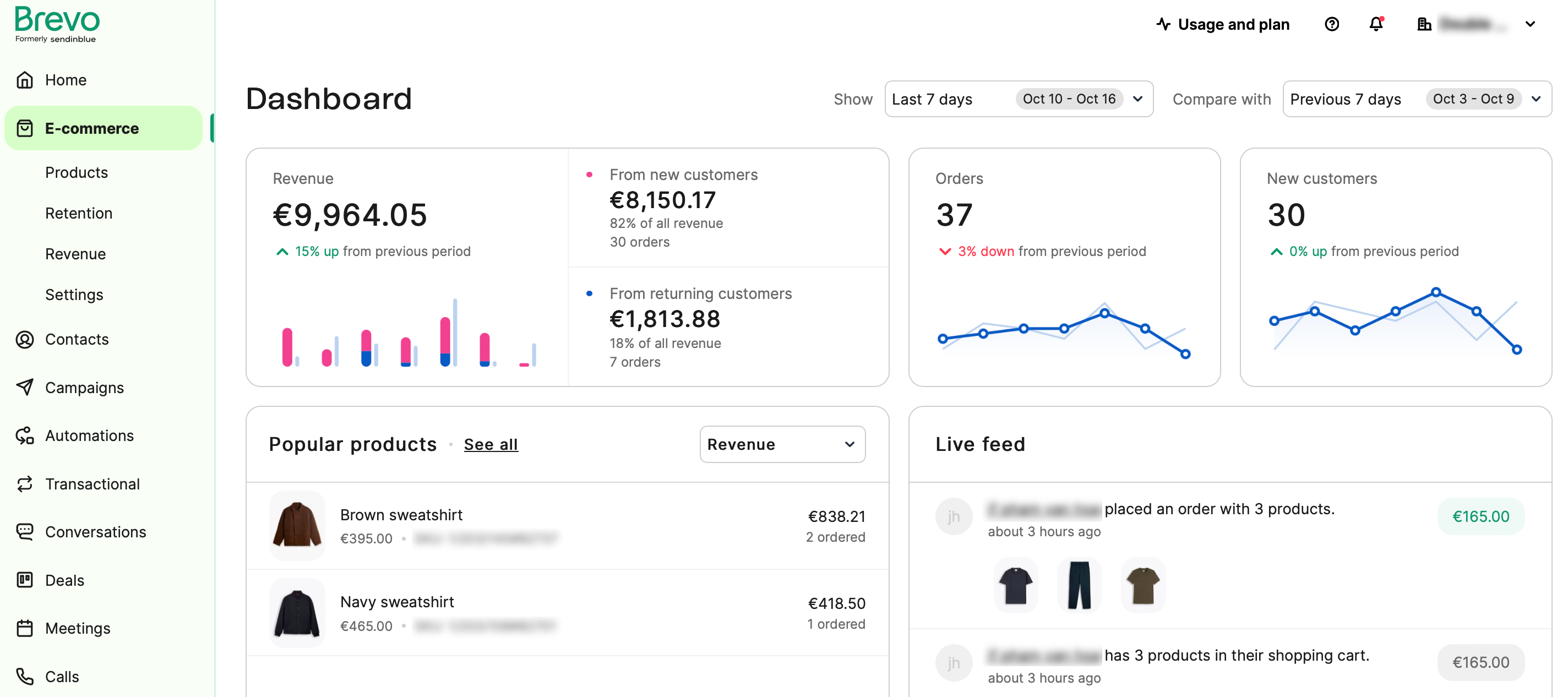
Key Features
- Transactional email capabilities. Automate purchase confirmations and shipping updates without external tools. Ensure reliable delivery of essential order-related emails;
- Flexible contact pricing. Pay based on email volume, not contacts—ideal for growing lists on a budget. Control costs as your list expands;
- Drag-and-drop editor. Easily design emails using intuitive tools and reusable email templates. No coding skills needed to create professional campaigns;
- Centralized platform. Offers CRM, SMS, and automation in one platform. Ideal for teams wanting centralized control without third-party tools.
Use Cases
- Ecommerce. Leverage automation features and transactional emails for lifecycle campaigns and cart recovery. This ensures customers receive the right message at the right time;
- Startups. A smart choice for cheap email marketing services and scalable pricing. You can grow your audience without upgrading too soon.
- Content Creators. Create and send beautiful updates using professional templates and user-friendly email newsletter software. It’s perfect for keeping fans and followers engaged.
Pros & Cons
- Multi-channel support
- Competitive pricing
- Built-in CRM functionality
- Strong transactional email support
- Inconsistent deliverability rate
- Reporting lacks advanced funnel tracking
- Restrictive free plan
Pricing Details
- Free tier: $0 (100,000 contacts—300 emails/day);
- Starter: $8/month (500 contacts—5,000 emails/month);
- Business: $16/month (2,500 contacts—Unlimited email sends);
- Enterprise: Custom price.
“Brevo bills based on total email sends rather than by total contacts, making it a much more affordable option than much of the competition. I also like that the company’s customer support is very responsive and easy to contact compared to the previous email service I used. Brevo made it very easy to switch everything over.”
— Charles’ review on G2
If Brevo has caught your attention, here’s a list of 11 Best Brevo Alternatives for Email Marketing (July 2025)
Klaviyo — Premium Ecommerce Platform with Steep Pricing
If you’re serious about email automation and customer data management, Klaviyo will be right up your alley. Its deep data tracking capabilities, advanced segmentation tool, and AI-driven insights make it one of the most high-end marketing solutions on the market.
Klaviyo pricing: Starts at $30/month for up to 1,000 contacts and up to 10,000 emails/month | Free plan available.
I tested Klaviyo for a simple Shopify store and built a multi-branch automation flow based on browsing behavior, cart value, and purchase history. It took some time, but the results were worth it—engagement rates improved noticeably, and I saw a clear uptick in conversions.
Meanwhile, features like predictive send timing and product-based recommendations help boost email campaign performance. Klaviyo’s interface may be a bit overwhelming for beginners, but advanced marketers and agencies managing custom ecommerce flows will appreciate the level of control and optimization options it offers.
Klaviyo is packed with a variety of features, including dynamic segmentation and AI-powered automation workflows. And while it does offer a free plan that gives you a taste of all the (limited) tools that come with an actual price tag, for all that Klaviyo has to offer—it’s definitely on the pricier side compared to most other options.
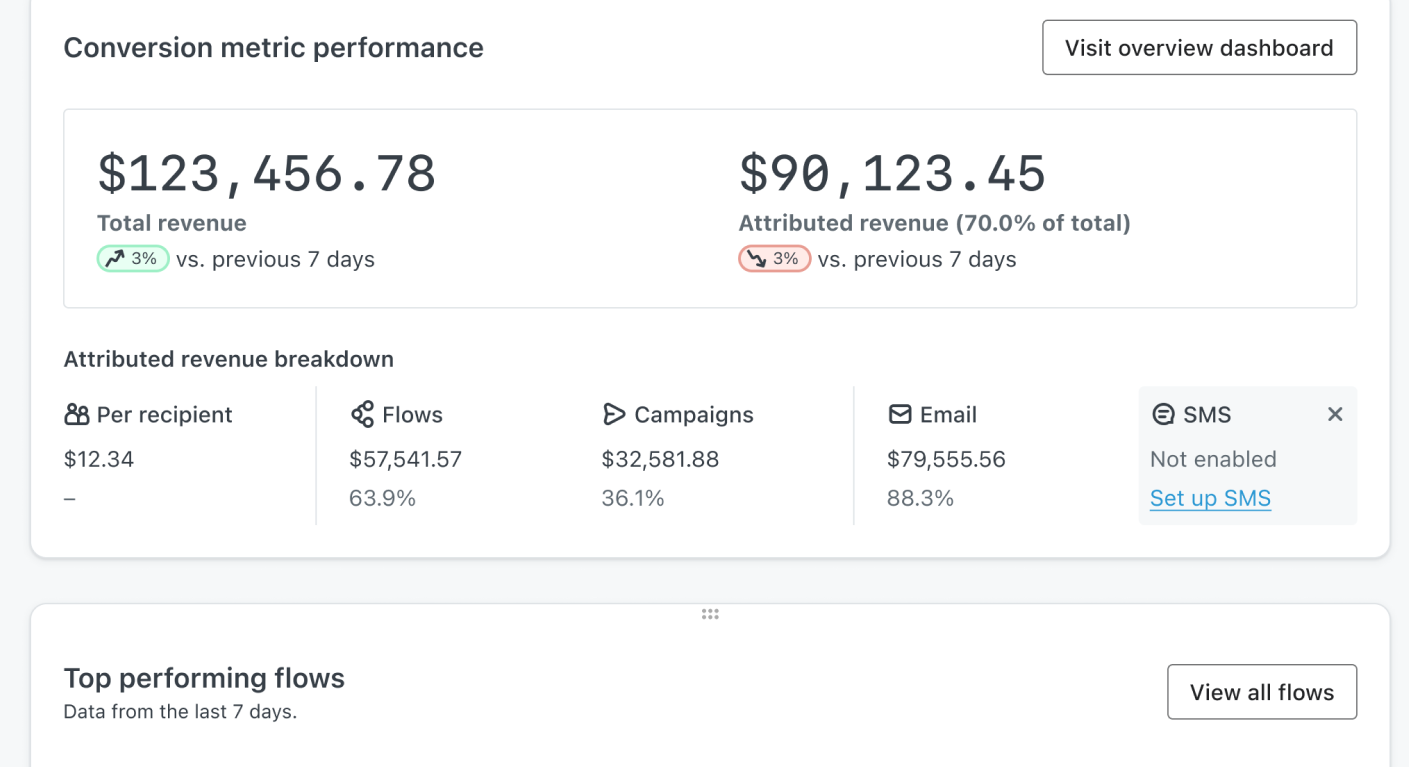
Key Features
- Data-driven segmentation. Create high-converting segments based on real-time behavior and purchase history. Improve engagement by sending hyper-relevant messages;
- Predictive analytics. Use AI to forecast revenue and customer lifetime value from campaigns. Make smarter decisions backed by real-time data;
- Advanced personalization. Build deeply customized flows using dynamic email templates. Increase conversions with content tailored to each user;
- Unified platform. Combines email, SMS, and analytics in one dashboard. Track performance and manage everything from a single source of truth.
Use Cases
- Scaling ecommerce brands. Use contact data to create hyper-personalized email and SMS campaigns;
- Subscription businesses. Automate retention emails based on churn risk prediction;
- High-volume retailers. Personalize emails and employ SMS marketing using AI-based suggestions.
Pros & Cons
- Deep ecommerce integration
- Strong automation features
- Top-tier A/B testing capabilities
- Intuitive visual automation builder
- Steep learning curve
- Support prioritizes higher-tier accounts
- Advanced features are behind a paywall
Pricing Details
- Free 60-day trial: $0 (250 contacts—500 email sends);
- Starter: $20/month (500 contacts—5,000 emails/month);
- Mid-tier plan: $100/month (5,000 contacts—50,000 emails/month);
- Enterprise: Custom price.
“Klaviyo is highly supportive for creativity and lets you create campaigns as well as triggered flows. I also find their regular tips newsletter that prove to be supportive for small businesses. Its also effective if you have subscribers from different time zones as you can automate sending the campaigns in local timings.”
— User’s review on G2
Also read: 10 Klaviyo Alternatives: Top Platforms for Ecommerce Businesses
Mailchimp — Popular Legacy Platform with Declining Value
Mailchimp is often the first email tool most businesses try—and after spending some time with it, I can see why. With its playful UI, wide brand recognition, and hundreds of integrations, it’s built a reputation as the go-to email marketing platform.
Mailchimp pricing: Starts at $20/month for up to 500 contacts and up to 6,000 emails/month | Free plan available.
I tested Mailchimp and set up a product launch campaign using Mailchimp’s Journey Builder, combining behavioral triggers, such as page visits and email opens. The flow was easy to map, but tweaking logic-based conditions felt limited.
Where Mailchimp shines is in branding elements. Its Creative Studio lets you store brand assets, reuse content, and maintain design consistency across campaigns, which I found helpful while managing seasonal collections.
When it comes to deliverability optimization, it doesn’t perform really well compared to competitors. Out of all the emails sent via Mailchimp, only 76.91% of the emails landed in the inbox. And although it offers robust automation features, Mailchimp’s segmentation struggles to keep up when managing larger subscriber lists.
Mailchimp’s once-generous free plan has also been heavily restricted. You’ll get fewer automation capabilities and very basic segmentation unless you upgrade—which is part of the reason why Mailchimp is losing its competitive edge, making many businesses actively seek Mailchimp alternatives.

Key Features
- Journey builder. Visual workflow editor for mapping out customer lifecycle campaigns. Plan complex email paths with ease;
- Creative studio. Centralized hub for brand assets, content, and design tools. Maintain brand consistency across campaigns effortlessly;
- Audience insights. Offers smart suggestions for campaign optimization, send times, and content. Boost click-through rates by monitoring user behavior and predictive insights;
- Extensive integrations. Connect with ecommerce, CRM, and analytics tools out of the box. Great for businesses already using a wide tool stack.
Use Cases
- Ecommerce brands. Use automation to recover abandoned carts and segment customers for personalized newsletters;
- Service-based businesses. Set up appointment scheduling and customer follow-ups;
- Bloggers & content creators. Ideal email marketing for bloggers who want to send regular newsletters, promote new posts, and build deeper connections with readers.
Pros & Cons
- Wide range of integrations
- Pulls product data into emails by connecting your store
- State-of-the-art AI tools
- Extensive analytics report
- Charges for inactive/unsubscribed contacts
- Limited advanced segmentation
- Templates can feel restrictive
- Pricing scales up quickly
Pricing Details
- Free plan: $0 (500 contacts—1,000 emails/month);
- Essentials: $12/month (500 contacts—5,000 emails/month);
- Standard: $20/month (500 contacts—6,000 emails/month);
- Premium plan: $299/month (10,000 contacts—150,000 emails/month).
“I am using the free plan, so my experiences are limited. But for my small business Mailchimp has worked great. Sending emails weekly is simple and putting really great emails out is important.”
— User’s review on Trustpilot
Constant Contact — Traditional Email Service with Outdated Interface
Constant Contact often appears on ‘best email marketing tools’ lists and caters to specific industries. If your business thrives on community engagement, webinars, or in-person events, Constant Contact will check all the right boxes.
While it may not offer the most advanced automations, it’s refreshingly straightforward and packed with niche-friendly features—like built-in donation forms, event RSVP tracking, and volunteer management tools.
Constant Contact pricing: Starts at $12/month for up to 500 contacts and up to 5,000 emails/month | Free plan is not available
When I tested Constant Contact with a dummy live workshop series, the event tools were reliable. I created a sign-up landing page, linked it to an RSVP-triggered email reminder, and customized the follow-up flow—all without touching a third-party platform.
However, there’s one drawback I noticed during our time with Constant Contact— its interface feels rather dated—which can make navigating and building campaigns feel less intuitive compared to more modern email marketing solutions.
The automation builder also felt limited—I couldn’t use behavior-based triggers without upgrading to the Premium plan. The fact that Constant Constant doesn’t offer a no-strings-attached Free forever plan like Sender doesn’t help either.
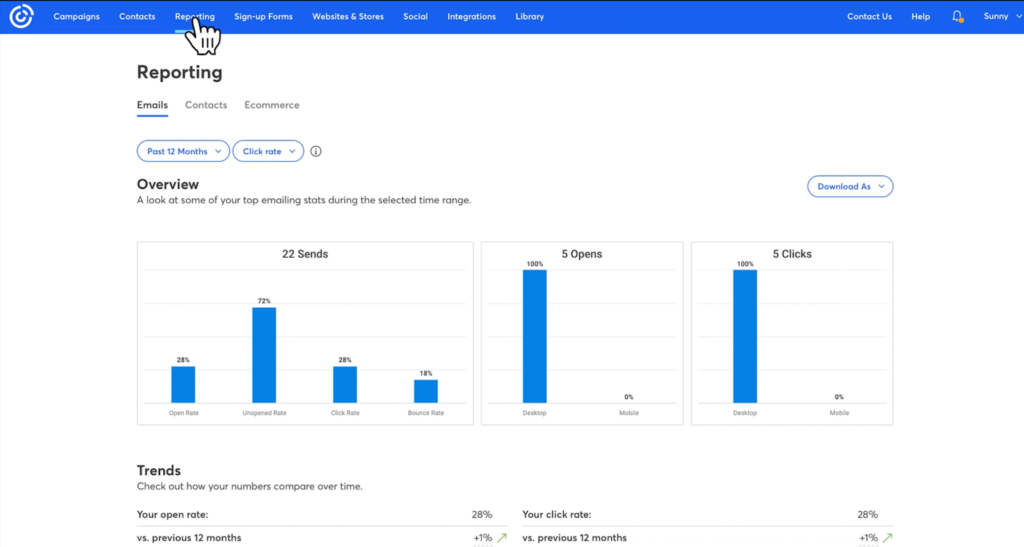
Key Features
- Intuitive landing page & email builder. Run end-to-end campaigns with list-building tools included. Perfect for promotions, events, and lead capture;
- Comprehensive event management tools. Organize and promote webinars, workshops, and fundraisers in one place without too much fuss;
- Responsive phone & chat support. Hands-on help makes it appealing to users needing guidance. Get real-time assistance whenever you’re stuck;
- Top-notch email & event marketing tools. Combine email templates with RSVP tools and reminders. Ideal for promoting and managing in-person or virtual events.
Use Cases
- SMBs. Build a funnel from landing pages to signup forms and campaign blasts. Useful for promotions, giveaways, or workshop series;
- Ecommerce. Basic automation lets you run post-purchase campaigns or re-engagement emails, though advanced retargeting may require integrations;
- Nonprofits. Send newsletters, donation appeals, and event invites from a single dashboard, with phone support when you need help.
Pros & Cons
- Intuitive drag-and-drop builder
- Timezone-based scheduling
- Excellent customer support
- Works seamlessly with ecommerce platforms
- Limited automation & segmentation
- Steep pricing model
- Outdated interface
- No ‘Free forever’ plan
Pricing Details
- Free 30-day trial: $0 (100 contacts—100 email sends);
- Lite: $12/month (500 contacts—5,000 emails/month);
- Standard: $35/month (500 contacts—6,000 emails/month);
- Premium: $80/month (500 contacts—12,000 emails/month).
“Been using over 2 years now. Constant Contact makes email marketing incredibly easy to manage, even for people who aren’t super tech-savvy. The drag-and-drop editor is intuitive, and there are plenty of well-designed templates that save tons of time. I also appreciate how organized everything is — from contact lists to campaign tracking.”
— Ivan’s review on G2
Drip — Ecommerce Specialist with Email-Only Limitations
If you’re a DTC brand ready to scale beyond beginner tools, Drip delivers ecommerce-specific automation that feels purpose-built, not patched together.
For starters, Drip doesn’t bother with CRMs or social tools like some of its competitors. Instead, it focuses entirely on delivering email campaigns that convert shoppers into buyers and browsers into loyal customers.
Drip pricing: Starts at $39/month for up to 2,500 contacts and unlimited emails | No free plan available
I tested Drip for a product launch sequence. The real-time revenue attribution feature is an interesting add-on here. I could easily see which emails were driving sales—often within just a few hours of sending. Drip’s advanced automation features, which are a must for every ecommerce vendor serious about email marketing, were solid as well.
While the setup required more technical know-how than some beginner-friendly tools like Brevo, the payoff is worth it if you have the budget.
The same goes for its 14-day trial—it gives you access to most of the advanced features, but it’s one of the shortest trials out there and might not be long enough to truly understand if it’s the right fit for your marketing needs.
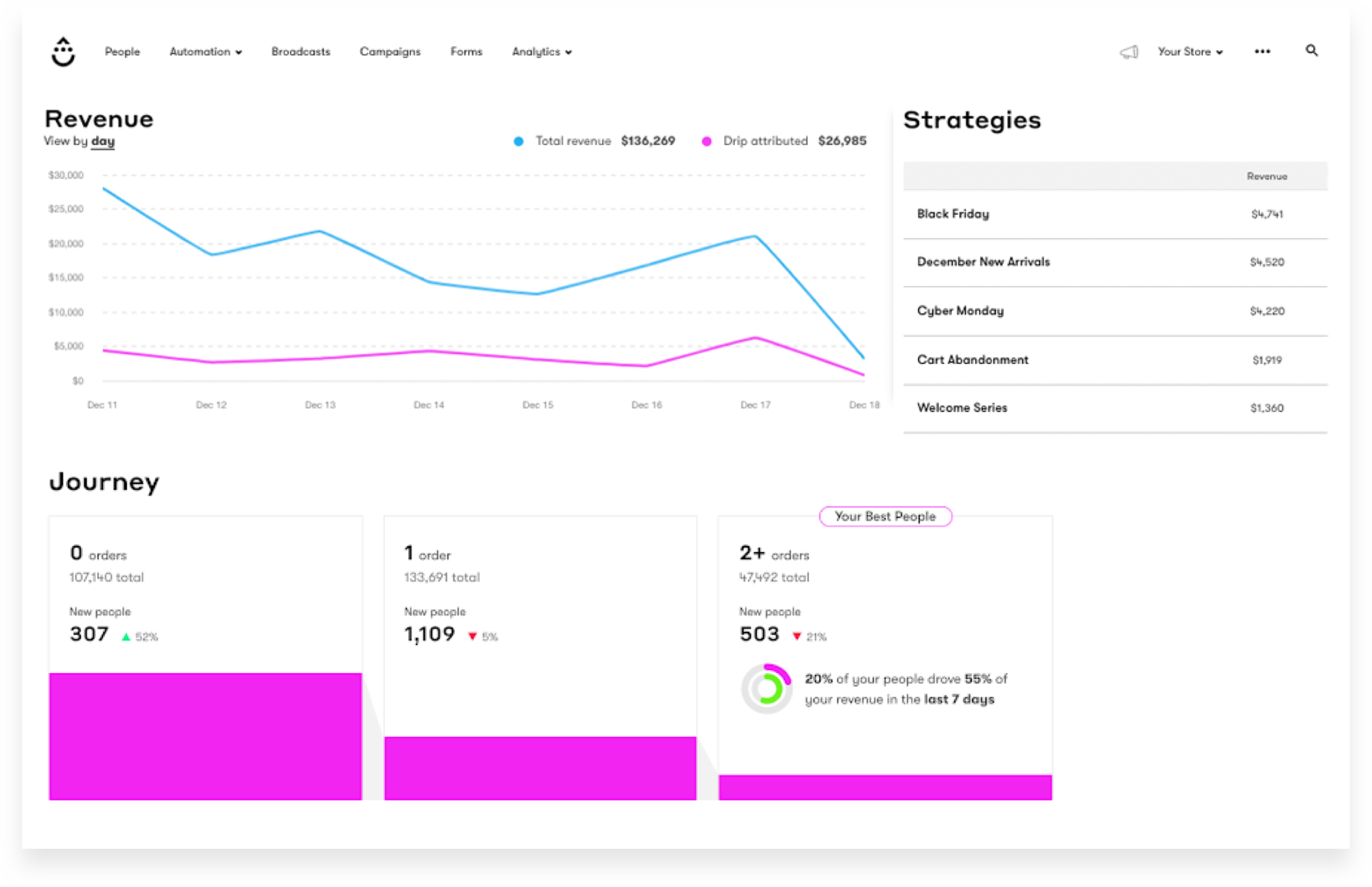
Key Features
- Ecommerce-focused automation. Track product views, abandoned carts, and purchase history in real time. Deliver behavior-based messages that drive sales;
- Revenue attribution. Tie every email to actual dollars earned. Clearly see which campaigns bring in the most revenue;
- Dynamic content blocks. Personalize emails on the fly based on user data. Each subscriber gets exactly what they need;
- Segmentation. Build lists based on quiz answers, time delays, or multi-event behavior chains.
Use Cases
- Shopify stores. Set up complex automations for upsells, loyalty rewards, and cart recovery;
- Subscription box businesses. Personalize emails based on purchase frequency and churn risk;
- Ecommerce brands. Use more advanced features like quizzes and gamification to make email sign-ups more interactive.
Pros & Cons
- Advanced automation
- Dynamic email segmentation
- Multi-channel marketing
- Real-time revenue attribution
- High-priced
- No landing page builder
- Steep learning curve
- No ‘Free forever’ plan
Pricing Details
- Free 14-day trial: $0 (500 email sends);
- Lite: $39/month (2,500 contacts—unlimited emails);
- Standard: $89/month (5,000 contacts—unlimited emails);
- Premium: $249/month (17,500 contacts—unlimited emails).
“Our email marketing is completely transformed through our work with Drip. Specifically, our team loves the automatic lead scoring system, which allows us to sort through the high volume of leads quite easily and determine high potential prospects right away.”
— Sasha’s review on Capterra
HubSpot — Enterprise All-in-One Solution with High Cost
HubSpot is more than an email marketing platform—it’s a central command center for businesses ready to scale marketing, sales, and customer service together.
With unified CRM data, deep automation tools, and smart content personalization, HubSpot turns email into a revenue engine for growth-stage teams.
Hubspot pricing: Starts at $11/month for up to 1,000 contacts and up to 2,000 emails/month | Free plan available.
I tried HubSpot to check how it can streamline lead nurturing in the B2B industry. By combining email sequences, dynamic lead scoring, and CRM filters, I triggered content recommendations based on demo activity and lifecycle stage.
While the email-only functionality seemed basic at first, HubSpot showed its strengths when tied to CRM, landing pages, and workflows. I also noticed that HubSpot offered full-funnel visibility to show how each email contributes not just to clicks, but to actual pipeline progression and revenue.
Finally, HubSpot’s free plan is surprisingly generous—offering web forms, email marketing, ticketing, tracking, and landing pages. It’s easily one of the best free all-in-one CRMs out there. However, when it comes to paid plans, the jump from $10 to eye-watering $923/month makes its pricing structure feel rather bewildering and steep as Mount Everest.

Key Features
- Full CRM & email suite. All-in-one unified platform connecting sales, service, and marketing. Eliminate silos and streamline communications;
- Smart content rules. Show different content based on user profiles and behaviors. Personalize the experience for each contact;
- Integrated lead scoring. Identify top prospects and tailor follow-ups accordingly. Focus efforts on the most engaged leads;
- Great collaboration sidebar. Keep your team aligned with a built-in sidebar that lets you share notes, view contact history, and collaborate on customer interactions.
Use Cases
- Enterprises & large teams. Manage complex workflows across multiple departments;
- B2B companies. Align email marketing efforts with sales process for lead nurturing & follow-ups;
- High-growth SaaS brands. Nurture leads with hyper-personalized and well-timed drip sequences.
Pros & Cons
- User-friendly interface
- Generous free plan
- Great CRM integration
- Insightful reporting
- High cost at scale
- Steep learning curve
- Basic templates
Pricing Details
- Free plan: $0 (1,000 contacts—500 email sends/day);
- Starter: $10/month (1,000 contacts—5,000 emails/month);
- Marketing Hub professional: $923/month (2,000 contacts—20,000 emails/month).
“As the Head of Growth and CRM Manager, I’ve found HubSpot Marketing Hub to be an invaluable tool for streamlining and scaling our marketing efforts. The all-in-one platform allows us to efficiently manage our email marketing, content, social media, and analytics in one place, making it a huge time-saver.”
— Thibaud’s review on G2
GetResponse — Multi-Feature Platform with Jack-of-All-Trades Approach
Over the years, GetResponse has evolved from a basic email platform into a full-fledged marketing hub with features like AI-powered recommendations and even an online course builder. Which makes it a popular choice amongst both content creators and online stores ready to scale.
GetResponse pricing: Starts at $15/month for up to 1,000 contacts and unlimited emails | 30-day free trial available.
I used GetResponse to set up a lead magnet + webinar campaign. Its intuitive autofunnel tool made the setup process a walk in the park for me. From the opt-in page to confirmation emails and a “thank you” sequence, the journey came together without needing multiple platforms or third-party integrations.
Plus, the AI email generator is a nice bonus, too. It helped me with email copy, subject line optimization, and CTAs, which I used for A/B testing. It also brought down the content creation time significantly.
The interface isn’t as sleek as some of its competitors’, but the variety of advanced features make it a worthy choice for creators who need more than just email marketing. GetResponse’s free trial deserves a mention too, offering access to basic email marketing, a website builder, and landing pages with no time limits.
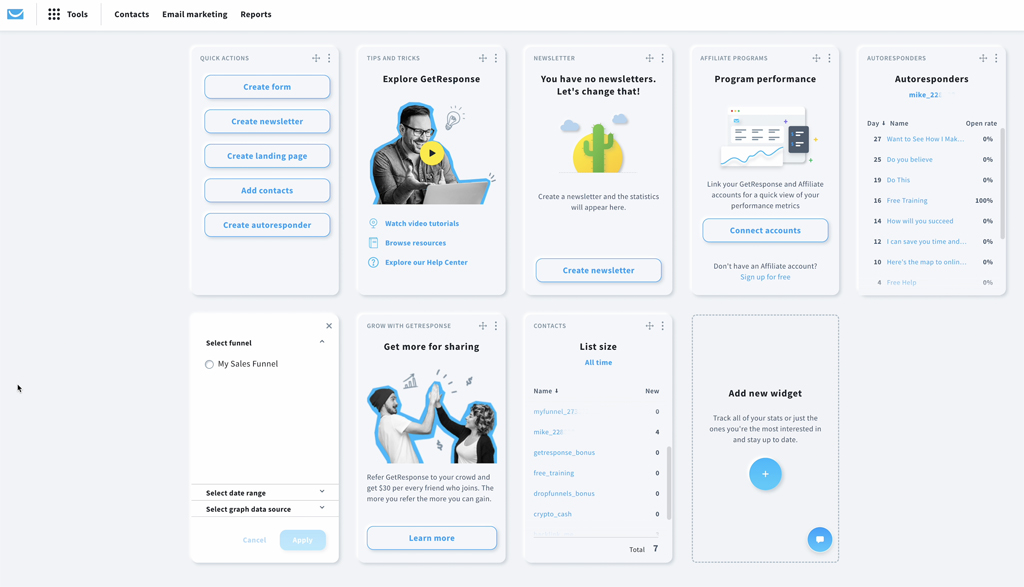
Key Features
- Autofunnel builder. Create full sales journeys from opt-in to conversion in one tool. Ideal for building revenue funnels without coding;
- Webinar integration. Run live sessions directly from your email platform. Educate and convert your audience in real time;
- AI email generator. Quickly produce optimized emails with smart copy suggestions. Save time and boost performance with AI-powered content;
- Conversion-focused tools. Includes landing pages, sales funnels, and automation in every plan. Built to drive leads and maximize ROI from day one.
Use Cases
- Ecommerce brands. Use AI product recommendations, abandoned cart emails, and sales tracking to boost conversions;
- Course creators & coaches. Sell courses and build automated email funnels to nurture prospective learners;
- B2B & SaaS companies. Plan complex email automations and integrate directly with a CRM system for lead management.
Pros & Cons
- Great conversion funnel functionality
- Design & spam testing tools
- Top-notch webinar hosting capabilities
- Intuitive visual workflow builder
- Limited A/B testing
- Clunky interface
- Limited automation capabilities
Pricing Details
- Free forever plan: $0 (500 contacts—2,500 emails/month);
- Starter: $15/month (1,000 contacts—unlimited emails);
- Marketer: $51/month (1,000 contacts—unlimited emails);
- Creator: $58/month (1,000 contacts—unlimited emails).
“I think the best feature GetResponse has is their customer support. Running email campaigns can be complicated, especially if you use all the different features like segmentation, webinars, and workflows. So it’s great to have someone in the live chat feature there to help you.”
— Jody’s review on G2
Also read: 10 Best GetResponse Alternatives in 2025 (Free & Paid)
EmailOctopus — Email Marketing Service for Basic Needs Only
If you’re a small business looking for a simple, budget-friendly newsletter tool, EmailOctopus is worth considering.
Unlike platforms packed with unnecessary features, EmailOctopus focuses purely on what small businesses need—newsletters and autoresponders, without the unnecessary complexity.
EmailOctopus Pricing: Starts at $9/month for up to 500 contacts and up to 10,000 emails/month | Free plan available.
During my hands-on time with EmailOctopus, I was able to set up a dummy campaign in under 15 minutes. The UI was clean and fast, and I didn’t need to dig through settings to figure out how to launch.
While email automation felt basic, missing things like workflow A/B testing, the welcome sequence and subscriber tagging worked without any hiccups for first-time buyers.
What stood out was Email Octopus’ deliverability. Many online reports link this to EmailOctopus using AmazonSES at the backend. Despite rather limited features, the emails consistently hit inboxes, even without warming up a new domain, which is ideal for creators or startups just getting started.
EmailOctopus’s Free Forever plan is also worth noting, providing core email marketing features and 10,000 email sends per month with no limits on the number of campaigns you can launch.
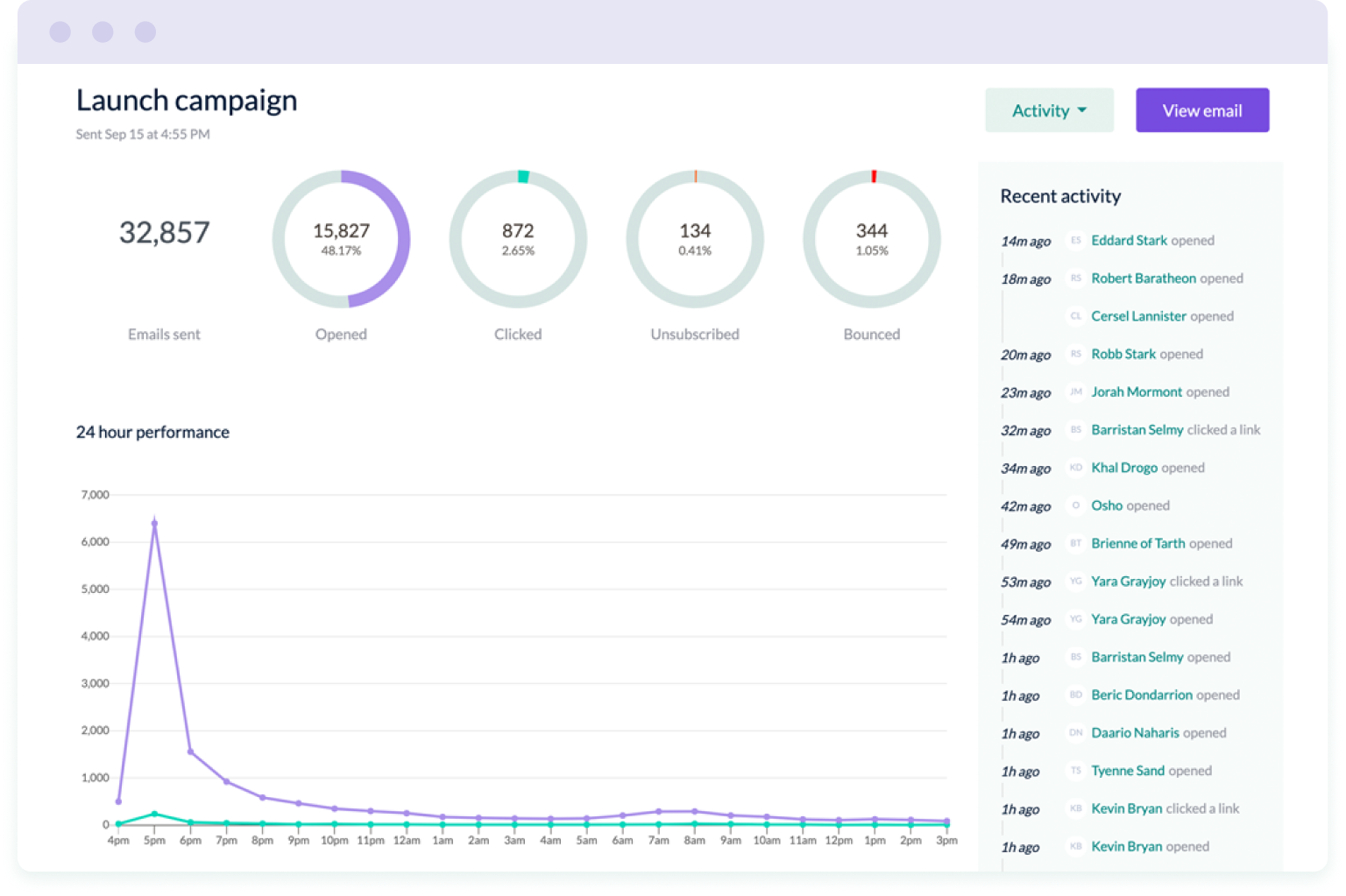
Key Features
- Simplicity & speed. Set up campaigns in minutes with minimal learning curve. Focus on content, not complicated tools;
- Affordable scalability. Keep costs low while growing your subscriber list. Excellent value for budget-conscious users;
- Clean email deliverability. Fewer bells and whistles, but solid for avoiding spam folders. Get into more inboxes, not junk folders;
- Lightweight platform for newsletters. Focuses on core features like email templates and list management. Perfect for small teams that value simplicity and speed.
Use Cases
- Bootstrapped startups. Run newsletters and send regular updates without complicating the operations;
- Affiliate marketers. Utilize bulk email advertising capabilities to set lead magnet autoresponders and track clicks from its simple analytics dashboard;
- Freelancers & creators. Grow your audience and send regular updates without increasing the cost of operations.
Pros & Cons
- Competitive pricing
- Great deliverability rates
- Generous free plan
- Distraction-free UI
- No CRM & detailed behavioral tracking
- Limited automation capabilities
- Small template library
- Limited native integrations
Pricing Details
- Free forever plan: $0 (2,500 contacts—10,000 emails/month);
- Pro: $9/month (500 contacts—10,000 emails/month).
“We switched to Email Octopus a couple of months ago and very happy with our experience of the platform. Lots of simple and easy design features and their tech support has been amazing – we receive instant feedback to any design/function queries using “real person chat” which is incredibly helpful.”
— Mily’s review on Trustpilot
Moosend — Affordable Automation Tool with Limited Templates
If you want a simple way to dive into email automation—without a hefty price tag—Moosend is worth a look.
Moosend doesn’t have the name recognition of bigger platforms, yet it delivers solid core functionality for bulk emailing at a budget-friendly price. I found its drag-and-drop editor and basic automation tools to be effective, if slightly limited, for setting up welcome emails or undemanding campaigns.
Moosend pricing: Paid plans start at $7/month for up to 500 contacts and unlimited email sends | Free 30-day trial available.
While Moosend’s library of pre-made email templates is somewhat limited, its clean and intuitive reporting dashboard makes it easy to track performance—making it a strong starting point for businesses exploring email automation options.
And even though Moosend doesn’t have a Free forever plan (like most of its competitors), it does offer a generous 30-day free trial that allows you to play around with some of its advanced features, including automation workflows, landing pages, and detailed analytics.
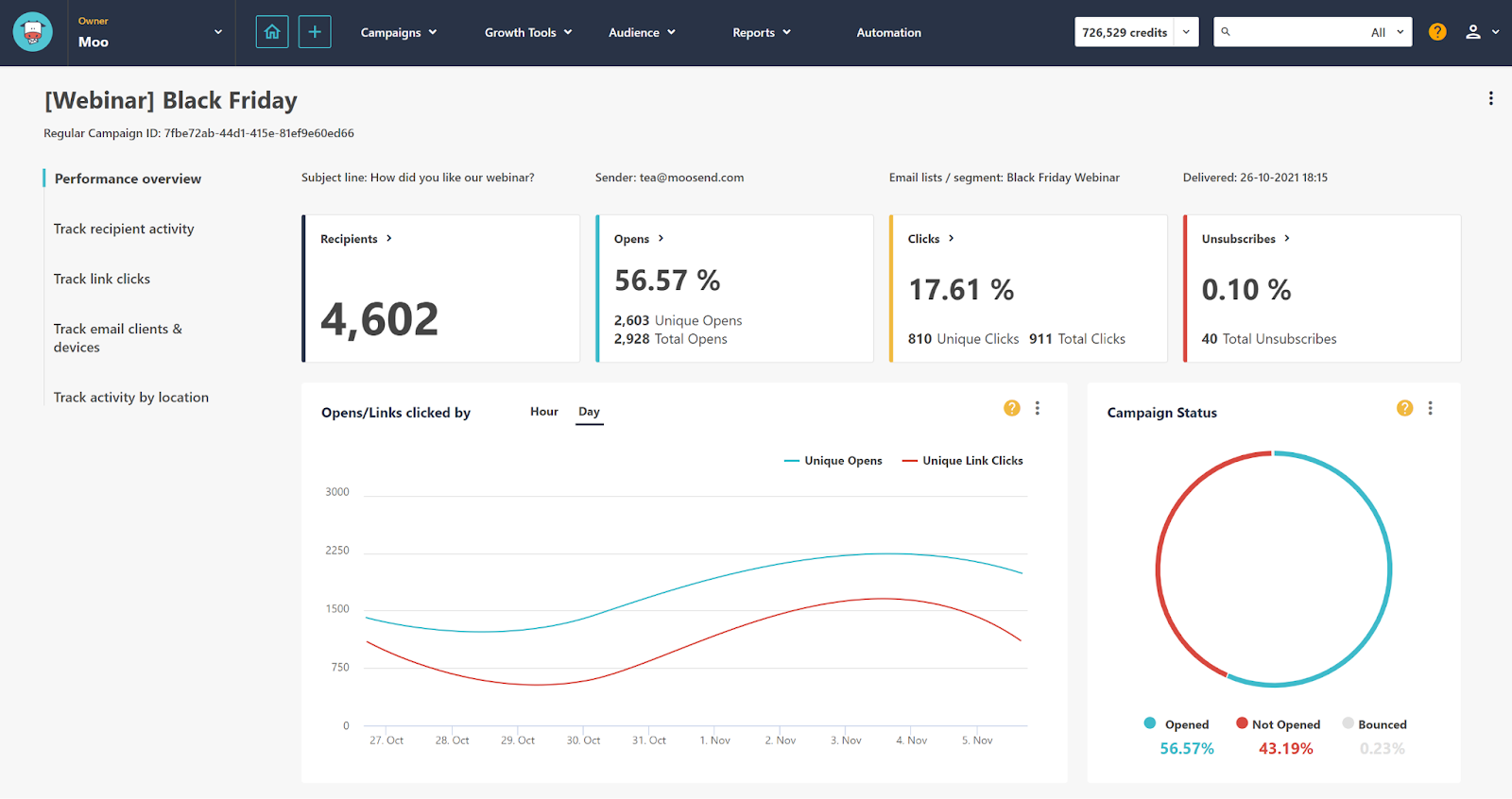
Key Features
- Robust automation workflows. Set up sophisticated email sequences effortlessly. Ensure timely, communication with your audience while saving time on manual tasks;
- User-friendly interface. Simple and intuitive design makes it easy to navigate, even for first-time users. The platform is built to minimize the learning curve for all skill levels;
- Advanced email personalization. Send tailored messages that resonate. Use dynamic content to create more meaningful and engaging subscriber experiences;
- Lead capture tools. Easily grow your list with customizable pop-ups and forms. Works smoothly with popular website platforms for fast, hassle-free setup.
Use Cases
- Ecommerce. Win back abandoned carts, tailor customer experiences, and boost repeat sales through targeted email campaigns;
- SaaS companies. Guide new users, highlight key features, and lower churn with automated sequences and customized messaging;
- Digital marketing agencies. Handle multiple client accounts, launch campaigns, and monitor results with in-depth performance analytics.
Pros & Cons
- Competitive pricing
- User-friendly interface
- Real-time analytics with device-level data
- Intuitive drag-and-drop builder
- Lacks advanced automation
- Limited templates
- Reporting lacks advanced funnel
- Lack of integrations
Pricing Details
- Free 14-day trial: $0 (1,000 contacts—unlimited emails);
- Pro: $7 (500 contacts—unlimited emails);
- Moosend+: Custom price (contact limit based on selected add-ons and volume—unlimited emails);
- Enterprise: Custom price.
“Moosend has many features for their newsletters that other companies don’t have. The wealth of templates and setups is staggering. It was easy to transfer my current newsletter subscriber list to Moosend. Their customer support is very responsive. They provide lots of feedback about clicks, deliverability, opens, etc.”
— Tracie’s review on G2
MailerLite — Beginner-Friendly Platform with Basic Feature Set
MailerLite is another beginner-friendly email marketing solution that offers essentials for those who are just starting out. With a clean interface and intuitive drag-and-drop editor, it makes creating professional-looking email campaigns easy.
MailerLite pricing: Starts at $9/month for up to 500 contacts and unlimited email sends | Free forever plan available.
MailerLite may not offer the advanced toolkit of platforms like Brevo or Sender, but it delivers on the essentials, such as basic automation, simple segmentation, as well as customer journey builder. I found these tools to be more than enough for running high-performing welcome emails without unnecessary hassle.
Additional features like a built-in website and landing page builder provide a simple way to extend your brand presence online—though they’re best suited for users with modest design and marketing needs.
Those looking for a solid, no-strings-attached free marketing platform will be happy to hear about MailerLite’s free plan. Not only does it support up to 1,000 subscribers and 12,000 emails per month, it also gets you access to core features like the drag-and-drop editor, automation tools, and up to 10 landing pages.
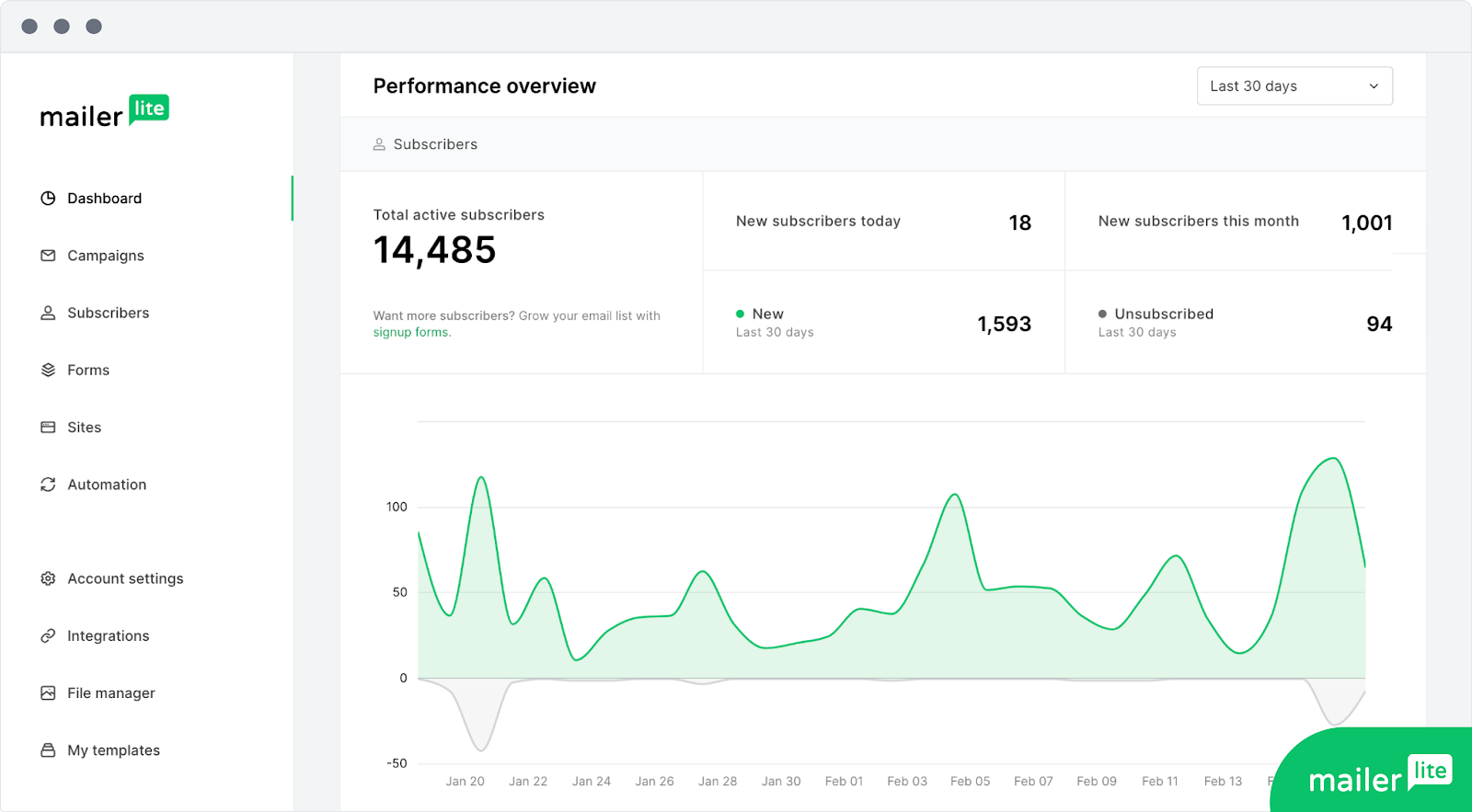
Key Features
- Landing page builder. Create stunning, conversion-focused pages without touching code;
- Generous free plan. Get started without spending a dime. The free tier includes core features like email sends, basic automations, and landing pages;
- AI writing assistant. Craft engaging copy faster. Generate subject lines, body text, and CTAs with AI suggestions designed to boost opens and clicks;
- Advanced reporting. Dive into detailed analytics on audience behavior, conversions, and campaign performance to refine strategy and maximize ROI.
Use Cases
- Bloggers & content creators. Grow your audience by sending regular email newsletters, sharing new blog posts, and building strong connections with readers;
- Small businesses and retailers. Promote new products, offer subscriber-only discounts, and boost customer loyalty through personalized email campaigns;
- Educational institutions. Keep students and faculty informed with targeted emails about course updates, events, and important deadlines, ensuring timely communication.
Pros & Cons
- Beginner-friendly
- Great segmentation functionality
- Competitive pricing
- Robust automation tools
- Subpar spam & design testing functionality
- Slow customer support
- Limited advanced features
Pricing Details
- Free forever plan: $0 (1,000 contacts—12,000 emails/month);
- Growing Business: $9 (500 contacts—unlimited emails);
- Advanced: $18/month (500 contacts—unlimited emails);
- Enterprise: Custom price.
“I’ve previously used some other well known solutions but since moving to Mailerlite have found the right balance of functionality, cost and service. The customer support is always prompt, friendly and thorough. Most of [the] time, however, I don’t need to contact support as the set-up and operation is intuitive.”
— Robert’s review on G2
Also read: 12 Best MailerLite Alternatives: Free & Paid Options (2025)
SendX — Simple Email Tool with Limited Scalability
If you’re just starting out or have a tight budget, SendX delivers surprising firepower at a low cost. With unlimited email sends, built-in automations, and no feature-gating across plans, it’s a smart pick for small teams who want essential marketing tools.
SendX Pricing: Starts at $8/month for up to 1,000 contacts and unlimited contacts | 14-day free trial only.
When I tried SendX, the setup process felt refreshingly quick. I had a welcome flow and the first campaign set up and running in under 20 minutes. And while the WYSIWYG email editor doesn’t have the flash of tools like Klaviyo, it’s still functional, responsive, and gets the job done.
SendX also offers robust user segmentation. It allowed me to easily target audiences with laser-like precision based on demographics, user behavior, and custom tags.
However, I found SendX to be less suited for fast-growing businesses, as its limited advanced features and occasional performance issues can make scaling rather tricky. And with only a 14-day trial available, there’s not enough time to fully explore its capabilities, before committing.
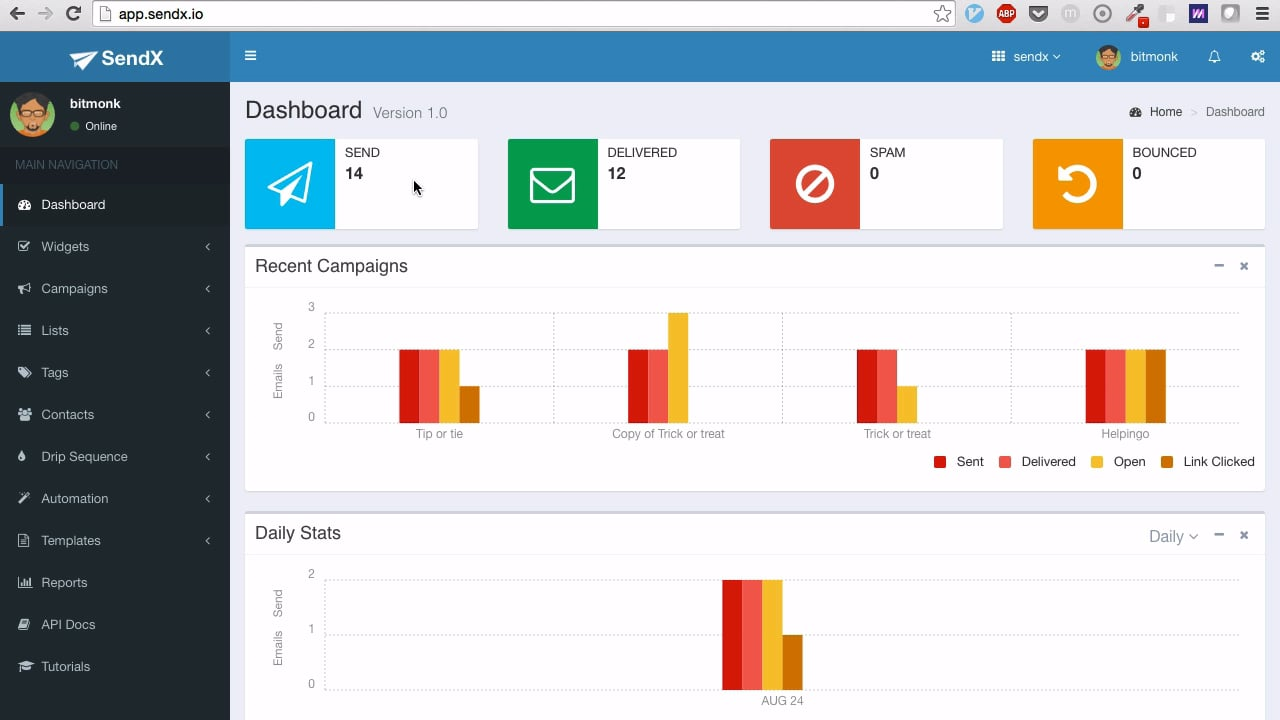
Key Features
- WYSIWYG editor. Build and send emails fast with easy drag-and-drop functionality. Launch polished campaigns without technical knowledge;
- Unlimited users. Ideal for teams managing multiple campaigns without extra costs. Collaborate freely without per-user pricing;
- Free email marketing. Great entry point for small businesses needing free email marketing software without feature limits. Everything essential is included.
Use Cases
- Small businesses & startups. Scale email marketing efforts with unlimited emails per month;
- Bloggers & course creators. Automate lead nurturing and engagement sequences using its drip sequence builder;
- Ecommerce & affiliate marketers. Set up automated newsletters and track email clicks and performance.
Pros & Cons
- Competitive pricing
- Strong deliverability rate
- Responsive customer support
- Strong core automation features
- Limited templates & landing pages
- Basic reporting tools
- No Free forever plan
- Basic email editor
Pricing Details
- Free 14-day trial: $0 (500 contacts—2,000 emails/month);
- Starter: $8/month (1,000 contacts—unlimited emails);
- Mid-priced tier: $40/month (10,000 contacts—unlimited emails);
- High-priced tier: $90/month (2,000 contacts—unlimited emails);
- SendX Plus plan: Custom price.
“I was searching a company who gives there best with the best service relationship too. and guess what my search ends here. Excellent support with good inbox. Plans are perfect. who ever searching for email solutions must try.”
— Adam’s review on Trustpilot
Kit — Creator-Focused Platform with Limited Business Applications
Kit isn’t your typical email marketing platform—think of it as a virtual marketing assistant for early-stage businesses and creators.
Designed to automate product announcements, boost repeat sales, and even manage sponsorships, Kit helps you monetize your list without needing a full-fledged marketing team.
Kit Pricing: Starts at $25/month for 1,000 subscribers and unlimited emails | Free plan available.
Kit works through a simple interface that feels like texting your assistant: “Send a promo for this product”. While it lacks creative control, the automation and task-based UX is ideal for solo operators who want “good enough” emails out fast.
I ran Kit through a test scenario and found it shines in doing the essentials, like setting up a campaign quickly. You can send a product announcement, trigger an abandoned cart email, and promote a digital download with almost no manual setup.
Unlike many competitors, Kit’s free Newsletter plan isn’t stripped down—you get access to real automation features at no hidden costs. The Creator Network also helps by connecting you with other creators for cross-promotion and growing your subscriber list naturally.
If there’s one place Kit falls short, it’s the business side. It handles simple tasks but lacks multi-channel workflows and deeper marketing journeys. Plus, its limited integrations mean you can’t fully sync with your store or other tools, making it challenging to grow beyond the basics.
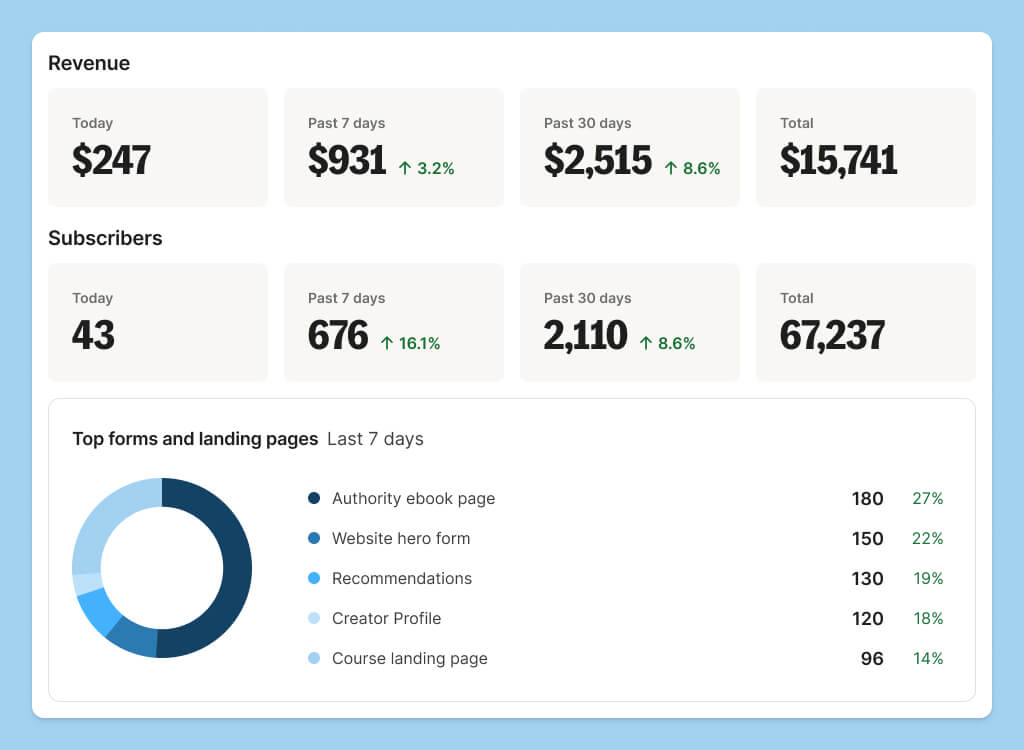
Kit Features
- Simple email campaign builder. Easily create and send product-focused emails with minimal setup. Great for Shopify users looking for quick wins;
- Virtual assistant-style UX. Handle tasks by chat for a zero-learning-curve experience. Perfect for solo founders or small teams;
- Product recommendation engine. Send smart product suggestions via email. Increase average order value with personalized content;
- Startup friendly. Built for founders who want marketing done without hiring help. Ideal for lean teams needing automation.
Use Cases
- Content creators & bloggers. Monetize your newsletter while growing an audience organically;
- Freelancers & coaches. Sell digital products and automate email sequences to nurture clients;
- Bootstrapped startups. Affordable automation to nurture leads and engage potential customers.
Pros & Cons
- Easy-to-use interface
- Intuitive visual automation builder
- Fast & responsive customer support
- Seamless tagging and segmentation
- Not fit for multi-channel workflows
- No true drag-and-drop email builder
- Lacks advanced B2B features
- Limited integration capabilities
Pricing Details
- Free Newsletter plan: $0 (10,000 contacts—unlimited emails);
- Creator: $25/month (1,000 contacts—unlimited emails);
- Creator Pro: $50/month (1,000 contacts—unlimited emails).
“Kit has been a game-changer for my client’s businesses. The intuitive interface and powerful automation features have helped me streamline their email marketing and find a way to build a loyal subscriber base for them.”
— Ricki’s review on Capterra
Email Marketing Platform Pricing Breakdown
Pricing can vary a lot between email platforms, especially as your contact list grows. Here’s a breakdown of email marketing pricing across 14 platforms on this list for various list sizes:
| Platform | 10,000 contacts | 30,000 contacts | 50,000 contacts |
| Sender | $40 | $103 | $159 |
| Omnisend | $92 | $237 | $289 |
| Brevo | Brevo charges on number of email sends every month, starting at $26/month for up to 20,000 monthly emails (with Brevo’s branding remaining). | ||
| Klaviyo | $165 | $515 | $720 |
| Mailchimp | $135 | $340 | $453 |
| Constant Contact | $120 | $310 | $430 |
| Drip | $154 | $449 | $699 |
| HubSpot | $410 | $1210 | $2010 |
| GetResponse | $66 | $142 | $246 |
| EmailOctopus | $40 | $107 | $160 |
| Moosend | $70 | $128 | $252 |
| MailerLite | $66 | $170 | $260 |
| SendX | $60 | $180 | $230 |
| Kit | $100 | $166 | $266 |
On the pricing front, Sender and EmailOctopus stand out as the most affordable options across all list sizes. Sender offers generous features even at its lower-tier plans, while EmailOctopus is budget-friendly and only suitable for straightforward newsletter sending.
On the other end of the spectrum, HubSpot, Klaviyo, and Constant Contact come with enterprise-grade features—but at a premium price. These platforms are better suited for large businesses that need deep automation, sales CRM, and behavioral data tracking baked into their email stack.
It’s also worth noting that Brevo doesn’t charge based on contacts but on the number of monthly email sends, which can be more economical for businesses with large lists but infrequent sending habits.
If none of the email marketing tools on this list tick all your boxes, take a look at the 10 cheapest email marketing platforms for savvy marketers.
How to Choose The Best Email Marketing Platform?
Picking the best emailing service isn’t just about features; it’s about fit. Here’s how to evaluate platforms based on your unique business goals and future growth:
- Test before committing. Use free trials or starter plans to test ease of use, deliverability, and core features. The best platform feels intuitive from day one.
- Identify your business-specific needs. Are you selling products, booking appointments, or running a newsletter? Your platform should support your core marketing flow, whether that’s ecommerce automation or content delivery.
- Evaluate essential features. Look for must-haves like drag-and-drop builders, automation workflows, segmentation, and analytics. Avoid platforms packed with flashy features you’ll never use.
- Assess deliverability performance. A beautiful email is useless if it lands in spam. Prioritize platforms with strong domain reputation tools, verified sender setups, unsubscribe handling, and proven inbox placement rates.
- Consider scalability and pricing structure. Don’t just choose based on the current list size. Check how pricing evolves as your contact list grows. Some tools become disproportionately expensive at scale.
- Check implementation and support quality. Great tools still need human help. Make sure onboarding, tutorials, and customer support are responsive, especially during campaign-critical moments.
FAQs about Email Marketing Platforms
What is an email marketing service?
An email marketing service helps you create, send, and manage email campaigns for your subscribers. It provides tools for designing emails, scheduling campaigns, automating follow-ups, and analyzing your marketing performance. You can use these platforms for executing your email marketing strategy and sending different types of email campaigns, like promotional campaigns, personalized reminders, abandoned cart recovery emails, etc.
What’s the best email platform for a small business?
Sender is a top choice for small businesses due to its user-friendly interface, affordable pricing, and robust features like a drag-and-drop email builder, professionally designed templates, tracking analytics, and automation capabilities.
It integrates well with other tools, offers high deliverability rates, and ensures mobile email optimization, making it an excellent platform for managing and growing email marketing campaigns, even as a free newsletter platform.
